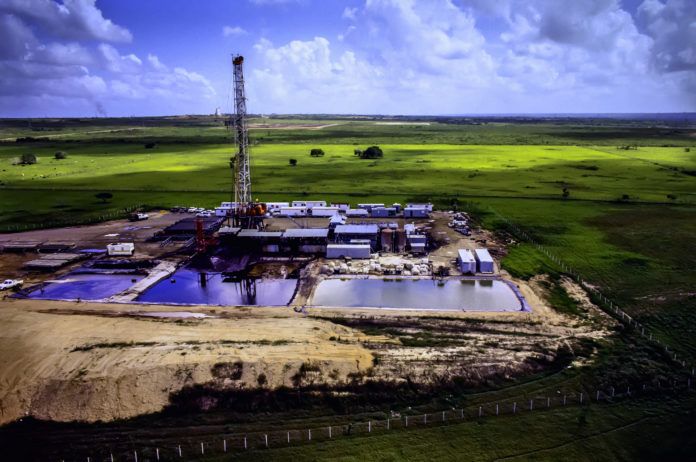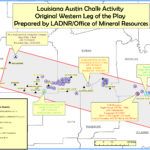The initial optimism that fracking technology would breathe new life into Louisiana’s Austin Chalk shale play has waned a bit in the last year. The first entrant into the play, ConocoPhillips, reported some rather dubious results in July from its exploratory wells in East Feliciana Parish.
The first three of ConocoPhillips’ wells produced more than 90% water and nowhere near enough oil to justify big investments, so the drilling of a planned fourth well was discontinued. While there was speculation that the oil company might probe the overlaying Tuscaloosa Marine Shale (TMS) in the same area, it eventually abandoned the idea and put its 234,000 acres up for sale in September.
That’s probably because TMS is an even riskier proposition, says Eric Smith, interim director of the Tulane Energy Institute in New Orleans. Austin Chalk essentially follows the same path as the TMS south and east across the lower half of the state, although at a shallower depth. “The Tuscaloosa Marine Shale, particularly north of Baton Rouge, isn’t all roses either,” Smith says. “The shale is fairly soft and it coalesces around the proppants. If the cracks don’t stay open, then you can’t get the oil or the gas out of the shale.”
While ConocoPhillips’ dismal results were disappointing, they by no means signal the death knell of the play’s eastern leg, says Kirk Barrrell, president of Amelia Resources LLC in New Orleans. Barrell generates drilling prospects in the onshore U.S., then leverages its data and experience to attract capital partners.
He believes that ConocoPhillips’ hydraulic fracturing process was likely too shallow and that adjustments can be made to make it more successful. “The high oil saturation is in the basal (lower) portion of the Austin Chalk and above that is a lot of water,” he says. “There were a lot of natural fractures, so the fracking forced a connection with the water-bearing section, making it hard to produce the oil.”
Barrell thinks the other major driller in the play’s eastern leg, EOG Resources Inc. of Houston, could tweak the design of the frack and get a better result.
Tulane’s Smith says it’s only a matter of time before technology saves the day. “They’ll keep at it. Over time they’ll figure out how to extend the laterals and better utilize the proppants.”
There are other large players interested in the shale’s eastern leg, but they’ve yet to pull the trigger. Barrell thinks they might be tapping the brakes because of the current business environment, combined with the inherent risk that comes with an unconventional site. “Wall Street has been very negative on the oil and gas sector in the last six months,” he adds. “Every move a publicly-held company makes is being watched and critiqued, so it might be a good time for them to pursue projects where there’s less risk and more predictability.”

Tyler Gray, president and general counsel of Louisiana Mid-Continent Oil and Gas Association, stresses that the only negative report so far has come from ConocoPhillips, and that development in the play might make more financial sense for other companies. “ConocoPhillips has so much invested in places such as Alaska that I think if it’s not really producing something that’s worth their time, they’re going to move on,” Gray says. “There is no comparing the production here with the production over there.”
LOOKING WEST
Meanwhile, the attention seems to have shifted to the play’s western leg. Jason Talbot, geologist supervisor with the Louisiana Office of Mineral Resources, says Marathon Oil, doing business as Southwind Oil & Gas LLC, is currently re-drilling a site in southern Rapides Parish, and other drilling permits have been issued to Torrent Oil LLC and EOG Resources in southern Avoyelles Parish, and Prime Rock Resources LA LLC and Prize Exploration & Production Co. in Vernon Parish.
“Marathon didn’t have a large enough rig to handle the pressure environment, and ended up just plugging the first well,” Talbot says. “They’re currently re-drilling on that same pad with a larger rig.”
Other players in Austin Chalk have been mostly silent about their findings, although numerous permits have been issued. Talbot says all companies in the play must submit a report to the state Department of Natural Resources’ Office of Conservation within 30 days of a well completion, and so far ConocoPhillips’ three failed wells are the only ones that have been reported.
Interest continues to grow in the extreme western leg of the play, perhaps because of its proximity to Texas where the drilling has been more lucrative. In September 2018, Equinor leased 60,000 acres in Vernon and Beauregard parishes and is currently performing a 107-square-mile 3D seismic survey of the area.
Nicole Baird, development and production manager for Equinor in Austin, Texas, updated her company’s findings at the Southern Energy Conference in Lafayette on Sept. 17. “We’ve tested the Austin Chalk and seen some promising results,” she says. “Once we get the seismic data at the end of the year, we’ll interpret it and plan and execute two exploration/appraisal wells, most likely at the beginning of 2020, depending on the conclusion of our seismic operations.
“Can we drill horizontal wells, do the completions and actually increase the productivity of the reservoir? That’s what we’re trying to determine.” Austin Chalk is Equinor’s most recent U.S. acquisition, joining other inshore shale developments at Appalachian Basin and Eagle Ford. Its global unconventional production is approximately 308,000 BOE (Barrel of Oil Equivalent) a day.
Baird hopes that her company’s previous experience in the Texas portion of Austin Chalk will provide certain advantages. “There is a lot of pressure for success.”
THE PRICE OF LAND
A low barrier to entry remains Austin Chalk’s biggest appeal, as land is cheap. The play also has a significant advantage over the widely publicized, but remote, Permian Basin in west Texas: takeaway capacity.
The area has an extensive infrastructure already in place, including pipelines and processes infrastructure, which the Permian doesn’t have. That’s because development in Austin Chalk is nothing new. Since the 1970s, there have been hundreds of wells drilled in the play, thereby providing a vast data set for potential prospectors. Louisiana DNR’s SONRIS (Strategic Online Natural Resources Information System) provides downloadable scanned well logs, and commercial vendors clean up the data to make it user friendly.
More recently, improvements in fracking technology have made the geological formation desirable once again. This time around companies are using a version of fracking technology that didn’t previously exist and are maintaining production for longer periods of time.
Still, Tulane’s Smith says any oil and gas derived from Louisiana’s shale plays—Austin Chalk, TMS or Haynesville—will be a drop in the bucket compared to the Permian Basin. “There are a bunch of companies up in the Haynesville Shale, but we’ve got very little in the way of operations in the southern part of the state right now … and getting fewer,” he adds. “We should stop thinking of Louisiana as an oil producing state. We’re a big state when it comes to downstream processing, transmission and turning oil into gasoline – and now exporting … but we’re not real big oil producers.”











